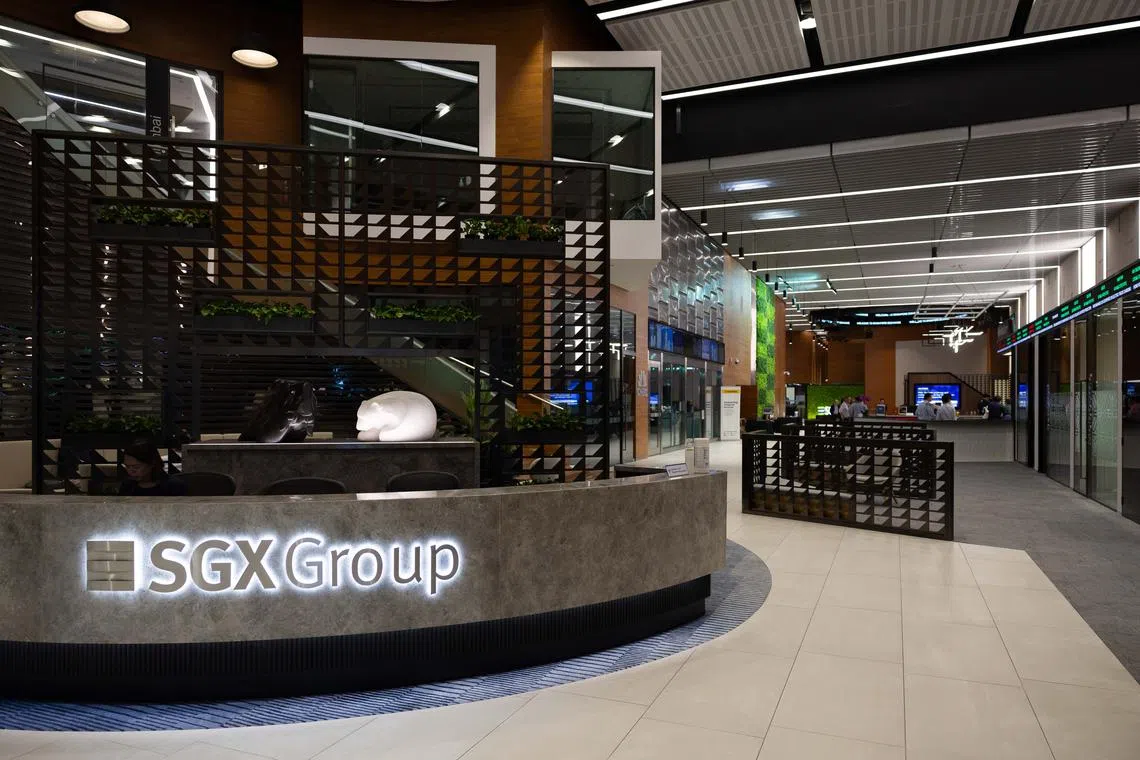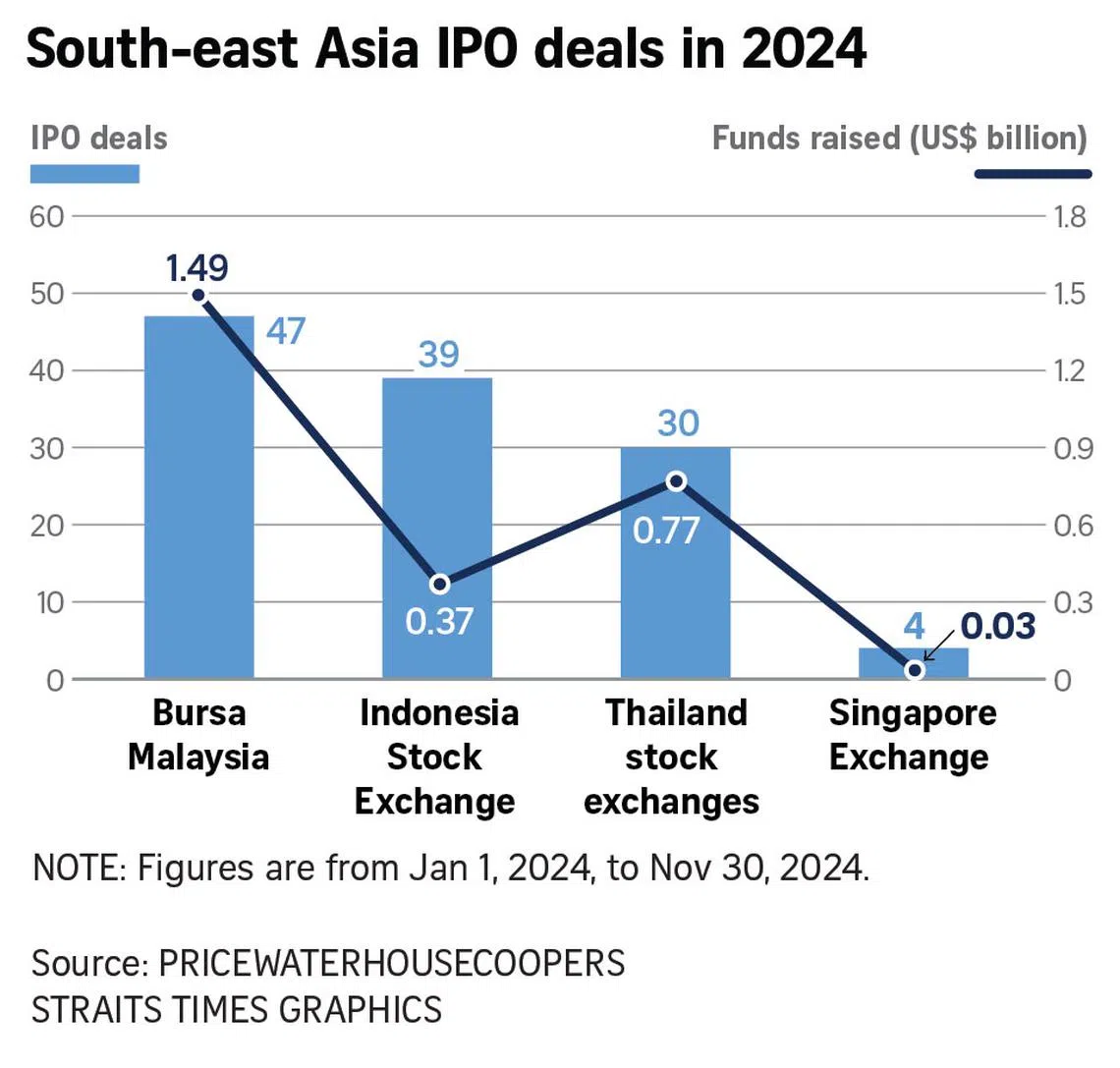SGX’s 4 IPOs in 2024 lowest in over a decade, but outlook is bright for 2025: Report
Sign up now: Get ST's newsletters delivered to your inbox

More healthcare and real estate sector listings are expected in 2025.
ST PHOTO: BRIAN TEO
Follow topic:
SINGAPORE – The Singapore Exchange (SGX) performed the worst in South-east Asia in 2024 in terms of initial public offerings (IPOs) and funds raised, but the outlook is brighter going into 2025.
There were only four listings here in 2024, raising relatively paltry sums, leaving the bourse far behind regional rivals.
It is also the worst performance since 2011, when professional services firm PricewaterhouseCoopers (PwC) started tracking the data.
The only way seems to be up, and indeed more healthcare and real estate sector listings are expected in 2025, PwC noted on Dec 16.
“With the global interest rate environment stabilising, coupled with ongoing government initiatives to revive the Singapore equity capital market, we remain cautiously optimistic that there are strong tailwinds for IPOs on the SGX as we head into 2025,” its report said.
PwC Singapore capital markets partner Jimmy Seet told The Straits Times that real estate investment trusts – or Reits – and healthcare are among the strongest pillars for SGX.
Reit IPOs usually draw the highest traction and funds raised due to Singapore’s well-established Reits regime, he said. Low interest rates also make borrowing cheaper and can make Reits more attractive.
“The previous hawkish interest rate environment has significantly impacted the SGX Reit IPO market and resulted in a halt in Reit listings, with the last one taking place in 2021. However, with expected rate cuts in the upcoming year, it is expected that interest in Reits will return,” he said.
Meanwhile, Mr Seet noted that the healthcare sector also benefits from long-term growth drivers such as ageing populations, increasing life expectancies and rising healthcare needs.
“In regions like Asia, which is home to a significant portion of the world’s population, the demand for healthcare services is expected to increase substantially,” he said.
“Companies in the healthcare sector will be attracted to raising capital in Singapore due to the country’s strategic location in Asia, making it an ideal hub for healthcare companies looking to access fast-growing markets in the region.”
The expected activity in 2025 will be in stark contrast to 2024, with the four listings – all on the Catalist board – that raised US$30 million (S$40.55 million) in all. This is in comparison with 47 listings on Bursa Malaysia, 39 on the Indonesia Stock Exchange and 30 in Thailand.

The largest deal here was the Singapore Institute of Advanced Medicine Holdings, a healthcare service provider that raised US$19.5 million. The other IPOs were Japanese restaurant operator Food Innovators Holdings; Attika Group, a commercial interior decoration and engineering firm; and karaoke chain operator Goodwill Entertainment.
The top 10 IPOs in the region were mostly listed in Malaysia and Thailand in 2024. The biggest IPO was 99 Speed Mart Retail Holdings, which raised US$510 million in Malaysia. This was followed by Thai Credit Bank Public Company’s US$200 million in Thailand.
Malaysia came up tops as the region’s best performer.
Mr Seet said: “I believe the government’s economic policies and regulatory changes have contributed to Bursa’s strong performance this year.”
However, he also pointed out that the SGX is more of an international exchange, while the regional stock exchanges are still quite domestically focused and cater to local companies.
He added: “Moving into 2025, I expect the regional exchanges to continue their upward momentum given the current strong pipeline of IPO candidates on these regional bourses.”
He also noted that the lack of an IPO on the SGX mainboard in 2024 could be due to the perceived poor liquidity and low valuations.
“Nonetheless, it is encouraging to see the Monetary Authority of Singapore (MAS) stepping in and forming a task force to examine measures to revive the equity capital markets in Singapore,” he said.
“Having a minister lead the committee demonstrates the importance placed by the Government on reviewing the current state of Singapore’s capital market.”
The MAS announced in August that it had set up a review group chaired by Minister for Transport and Second Minister for Finance Chee Hong Tat to recommend measures to strengthen the Singapore equities market. It will report within 12 months.
But another bright spot for the SGX could rest with more secondary listings, the PwC report noted.
There were two secondary listings on the SGX: PC Partner Group, which designs and manufactures computer electronics; and Helens International Holdings, a market leader in China’s bar industry.
They were both introductory listings with no funds raised.
“There is a notable trend of companies seeking secondary listings in Singapore, which demonstrates SGX’s unique niche in appealing to companies who are keen to widen the depth of their shareholder base,” the report said.
Mr Seet added that Singapore is often seen as a gateway to penetrate South-east Asia. Companies keen to expand into the region may want to use SGX as a platform to enhance their visibility and credibility.
“Also, with more family offices being set up in Singapore, companies may look to diversify their investor base by seeking a secondary listing on SGX,” he noted.


